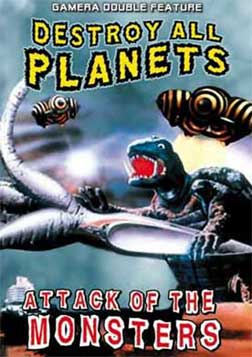 DESTROY
ALL PLANETS (1968)/ATTACK OF THE MONSTERS
(1969)
DESTROY
ALL PLANETS (1968)/ATTACK OF THE MONSTERS
(1969)Director: Noriaki Yuasa
Retromedia
 DESTROY
ALL PLANETS (1968)/ATTACK OF THE MONSTERS
(1969)
DESTROY
ALL PLANETS (1968)/ATTACK OF THE MONSTERS
(1969)A decade after Japan's Toho Studios
made Godzilla a cultural icon, another Japanese company, Daiei, introduced a
new giant monster of their own. The flying turtle Gamera made his debut in 1965
and was a smash when his first outing was released to American theaters the
following year. The film was in black and white, but the sequels were all in
color and all but one (1971's GAMERA VS. ZIGRA) were released directly to the
U.S. home market by American International Pictures-TV (AIP-TV for short). In
typical AIP fashion, the original titles were changed to give them that epic
monster hype, and in all but one case, Gamera's name was omitted.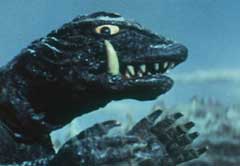
Like Godzilla, Gamera was a friend to children, and by the third film, he was a good monster as imposed to an evil, city-stomping one. The Gamera films usually had kids as the main characters in the plots (even more so than with Godzilla), but the monster battles were surprisingly more violent, with the massive turtle's thick green blood flowing freely. And although the Gamera films were shown primarily on television in the States, this "man in a rubber suit" figure has still had a major impact on monster fans who grew up in the 60s and 70s watching them on Saturday afternoon, and if you live in New York, "The 4:30 Movie."
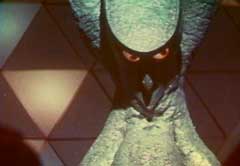 Retromedia
has released two of the more well-known Gamera films on DVD as a double feature,
complete with their original "AIP" logos. The first film on this set
is 1968's DESTROY ALL PLANETS, which involves two Boy Scouts (one Japanese and
one American) abducted by a Ping Pong ball spaceship. In it, they find some
gloomy aliens that look like Japanese surgeons, and are held prisoners.
Retromedia
has released two of the more well-known Gamera films on DVD as a double feature,
complete with their original "AIP" logos. The first film on this set
is 1968's DESTROY ALL PLANETS, which involves two Boy Scouts (one Japanese and
one American) abducted by a Ping Pong ball spaceship. In it, they find some
gloomy aliens that look like Japanese surgeons, and are held prisoners.
Most of the film is padded with
footage from the previous three Gamera movies. Scenes from the original black
and white film represent the point where the aliens control Gamera's mind and
turn him on Japan, and most of the his nighttime clash with Gaos from RETURN
OF THE GIANT MONSTERS is also present. The later half concentrates on new footage
with Viras, a disturbing squid creature who is actually the leader of the aliens.
Viras grows huge by chopping off the heads of his surgeon henchman and manifesting
their bodies to be able to fight Gamera. A bloody battle ensues with Gamera
being impaled by Viras' head, but he regains his strength and continues to fight
in order to save the boys.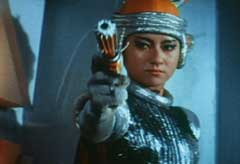
The other title on this DVD set is the following year's ATTACK OF THE MONSTERS. The plot has two star-gazing boys (again, one Japanese and one American) discovering an abandoned flying saucer in the woods. They are able to pilot the ship to a planet where a knife-headed monster called Guiron slices up a silver-tinged Gaos, and later does extensive fighting with Gamera (watch as the giant flying turtle does gymnastics!). Guiron is unique in that he shoots deadly Ninja stars from his head, making for some tough competition for Gamera. Meanwhile, the boys discovery that the unique-looking planet is inhabited by two alien women. They seem real friendly at first, but the jelly donuts and milk they are treated to is actually a scheme to drug them and eat their brains! Don't worry, even though one of the boys has his head shaved, no brains are actually eaten.
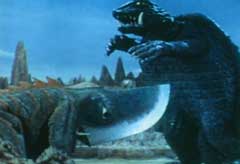 The
DVD release of these two films marks a nice return to the AIP versions we're
all used to. In the 80s, Sandy Franks issued re-dubbed versions of the Gamera
films, but they lacked the charm and personality of what we originally saw in
this country. Retromedia's release of both are of course the panned & scanned
full frame editions, since the original 2:35.1 ratios were never seen here in
English. DESTROY ALL PLANETS is passable: some of the colors are faded and the
image is a bit soft. ATTACK OF THE MONSTERS on the other hand has very vibrant
colors and is taken from a nice clean print source. The image is very sharp
despite some grain caused by the p&s zooming. Audio on both titles is fine.
The
DVD release of these two films marks a nice return to the AIP versions we're
all used to. In the 80s, Sandy Franks issued re-dubbed versions of the Gamera
films, but they lacked the charm and personality of what we originally saw in
this country. Retromedia's release of both are of course the panned & scanned
full frame editions, since the original 2:35.1 ratios were never seen here in
English. DESTROY ALL PLANETS is passable: some of the colors are faded and the
image is a bit soft. ATTACK OF THE MONSTERS on the other hand has very vibrant
colors and is taken from a nice clean print source. The image is very sharp
despite some grain caused by the p&s zooming. Audio on both titles is fine.
Extras on the disc include two
really nice still/poster galleries, and there are liner notes by Christopher
William Koenig. (George R. Reis)